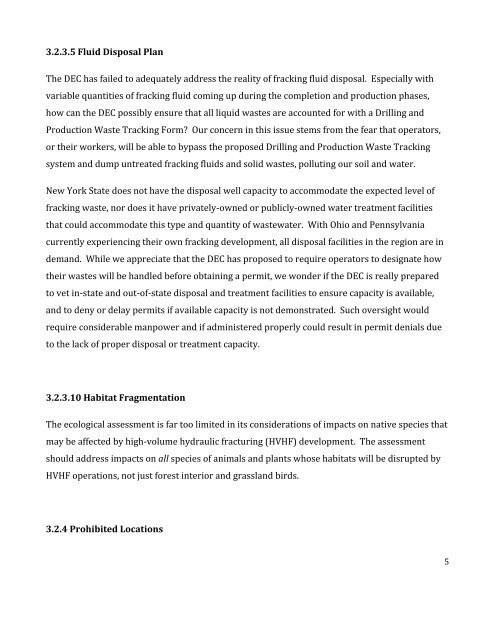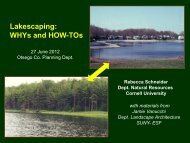file. - Otsego County Conservation Association
file. - Otsego County Conservation Association
file. - Otsego County Conservation Association
Create successful ePaper yourself
Turn your PDF publications into a flip-book with our unique Google optimized e-Paper software.
3.2.3.5 Fluid Disposal Plan<br />
The DEC has failed to adequately address the reality of fracking fluid disposal. Especially with<br />
variable quantities of fracking fluid coming up during the completion and production phases,<br />
how can the DEC possibly ensure that all liquid wastes are accounted for with a Drilling and<br />
Production Waste Tracking Form? Our concern in this issue stems from the fear that operators,<br />
or their workers, will be able to bypass the proposed Drilling and Production Waste Tracking<br />
system and dump untreated fracking fluids and solid wastes, polluting our soil and water.<br />
New York State does not have the disposal well capacity to accommodate the expected level of<br />
fracking waste, nor does it have privately-owned or publicly-owned water treatment facilities<br />
that could accommodate this type and quantity of wastewater. With Ohio and Pennsylvania<br />
currently experiencing their own fracking development, all disposal facilities in the region are in<br />
demand. While we appreciate that the DEC has proposed to require operators to designate how<br />
their wastes will be handled before obtaining a permit, we wonder if the DEC is really prepared<br />
to vet in-state and out-of-state disposal and treatment facilities to ensure capacity is available,<br />
and to deny or delay permits if available capacity is not demonstrated. Such oversight would<br />
require considerable manpower and if administered properly could result in permit denials due<br />
to the lack of proper disposal or treatment capacity.<br />
3.2.3.10 Habitat Fragmentation<br />
The ecological assessment is far too limited in its considerations of impacts on native species that<br />
may be affected by high-volume hydraulic fracturing (HVHF) development. The assessment<br />
should address impacts on all species of animals and plants whose habitats will be disrupted by<br />
HVHF operations, not just forest interior and grassland birds.<br />
3.2.4 Prohibited Locations<br />
5




